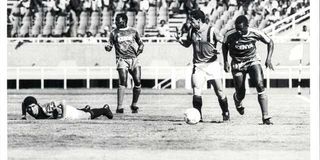Breaking News: At least 10 feared to have drowned in Makueni river
Talanta Hela can borrow from youth development centres of the 1970s

Part of the action between Kenya and Egypt during the All African Games at Kasarani in July 1987.
What you need to know:
- There is no need reinventing the wheel. Talent is out there at the grassroots, we just need a reliable, working system that ensures we select the best talent for our national teams in each age category.
All this week, my mind has been on the Kenyan football team that reached the final of the 1987 All African Games (currently African Games),and what the local football administration at the time did to enable the country produce a team capable of playing in the final of a major football tournament in Africa.
I should point out that at the time, football at the All Africa Games attracted senior national teams from the continent, unlike today when countries choose to field their Under-23 teams.
That team made up of John Busolo, George Odembo “Nyangi”, Austin Oduor, Ambrose Ayoyi, Sammy Onyango “Jogoo”, Davis Oyiela, Charles Otieno, George Onyango “Fundi”, Peter Dawo, Wilberforce Mulamba, Mickey “T9” Weche, James Nandwa, David Odhiambo, Wycliff Anyangu, goalkeeper David Ochieng, and Hassan Juma thrilled local fans on their way to playing in the football final of the 1987 All Africa Games at a spanking new Moi International Sports Centre, Kasarani which was built specifically to host the games.
In what is easily Kenya’s best performance in a continental championship, Harambee Stars, coached by the late Reinhardt Fabisch, beat Group ‘A’ opponents Tunisia 1-0, drew 3-3 with a full-strength Cameroonian side, and beat Madagascar 2-0 to qualify for the semi-finals against expectations.
Kenya played Malawi in a bizarre semi-final match that stretched over two days. Malawi dominated Kenya at Kasarani Stadium and as dusk fell, stadium lights failed and the match was suspended, with the teams tied 0-0.
The match was replayed the next day and Kenya won 3-2 on penalties after 0-0 draw, prompting a huge outcry from the Malawians that the home team had been saved from a looming defeat by the stadium lights. Kenya lost 1-0 to Egypt in the final, but the players left the tournament proud of their performance.
It is instructive to note that most of the players in that team came through the Youth Olympic Centres established in the 1970s set by Polish-German coach Bernhard Zgoll.
“We played our hearts out and made our people proud. Practically everyone in that team was a top talent, from the substitutes to the starting eleven, and we beat a top team like Cameroon which was riding high at the time.
At the time, we had talent development systems that worked,” Nandwa, who was among the young members of that squad, told me, joy and excitement evident in his voice.
Equally formidable was the Harambee Stars squad of 1972 that qualified for the Africa Cup of Nations for the first time.
It had goalkeeper James Siang’a, Jonathan Niva, Samson Odore, Austine Oduor, Daniel Anyanzwa, Peter Ouma, Allan Thigo, Jackson Aluko, John Nyawanga, Chege Ouma, Nicodemus Arudhi, John Chore, and Stephen Yongo. Although Kenya finished third in Group ‘A’ behind hosts Cameroon and Mali to exit the championship, the squad captured the imagination of Kenyans by qualifying for Afcon tournament for the first time at a time when it was an eight-team affair and probably more competitive than the current 24-team format.
Like the debate as to who is the world’s greatest footballer, it is difficult to settle the debate on which of these is Kenya’s best football team ever.
Playing at different times, both captured the imagination of the country in a manner never seen before.
Acts of omission and commission in the management of Kenyan football has made it even harder to settle the debate because there is very little by way of official records and statistics of the individual players.
But I like the wisdom that led to establishment of a series of national youth development centres across the country to develop football talent in the 70s.
In seeking to roll out Talanta Hela Programme that seeks to develop football from the grassroots, Sports Cabinet Secretary Ababu Namwamba can borrow from the template that Polish-German coach Zgoll used as he went about developing football talent in centres located in Kisumu, Mombasa, Nairobi, Kakamega, and Nakuru.
There is no need reinventing the wheel. Talent is out there at the grassroots, we just need a reliable, working system that ensures we select the best talent for our national teams in each age category.




